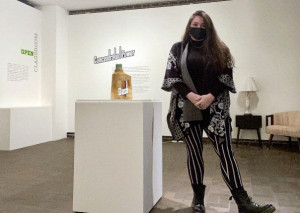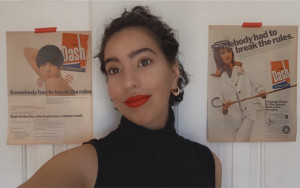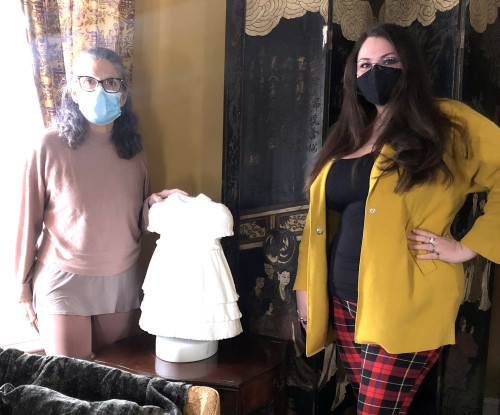A Peek into the Open Classroom: Concentrated Power
The latest Open Classroom project by Purchase M+ graduate students debuts this week at the Neuberger Museum of Art.
Concentrated Power is organized by Rebecca E. M. Ribeiro, Veronica Murphy, Meg Byron, and Shunyo Aizawa Morgan — the curatorial cohort of Purchase College’s Art History Exhibition course (2020-2021).

Open Classroom projects focus on multiple ways of engaging with a single work in the museum’s permanent collection. This semester the gallery lights shine on Barbara Ségal’s Dash (1994), a mixed stone replica of the classic laundry detergent bottle recreated to scale down to the smallest detail.
I had the opportunity to speak with class members and fellow Neuberger interns Rebecca (Rem) Ribeiro and Veronica Murphy to learn more about their experience curating this project:
What do you want people who come to see Concentrated Power to take away from their experience in the space?
Veronica Murphy ’21 MA (Art History), NEU Archives Intern:

Rebecca Elisabeta Marya Ribeiro ’21 MA (Art History) NEU Research Fellow:
Because so much of my work as an art historian and an aspiring curator focuses on gender critique both in and out of the art realm, I really want people to sit with the work and the supplemental materials we have curated, and contemplate the ways “feminine” engendering occurs. Now more than ever, with the current shift in feminism, the gender binary is being critiqued and broken down. There’s so much discourse around the performativity of gender, and how the use of certain objects – like laundry detergent – have contributed to that performativity throughout history.
What have you learned from curating this specific exhibition project?

Veronica: I’ve learned a lot these last two semesters while working on this exhibition, it’s been a privilege to learn so much from everyone in the Museum and the program. The most prevalent lesson has been understanding the importance of the details, they are really what makes everything come together. Whether you’re evaluating how bright the lighting should be, what angle best suits an art object in the space you’re working with, how high up on the wall to place labels, the spacing in between objects in the room, or how you anticipate someone will read the words you write on the label, they all seem to fit together like puzzle pieces. It takes a lot of experimentation to figure out the best choices, but all of these seemingly small details really do play big roles.
What was it like to work with a local, living artist?
Rem: Veronica had the absolute pleasure of speaking individually with the artist – and she was also able to visit the artist’s studio – which she can talk more about! In terms of my own experiences with the artist, it was absolutely incredible and validating to hear that – as an educator herself – she was so thrilled that this work was not only being taken out of storage, but that people were thinking so critically, seriously, and multidimensionally about her work. Because she is still working, it added all the more pressure to ensure that we were doing the work – and the artist – the justice that it absolutely deserves. Artist Barbara Ségal with M+ Graduate Student Veronica Murphy. Photo by Kristen Lindberg.

What is the message you’d like to send to undergrad students on campus curious about the graduate program on campus?
Veronica: This grad program has challenged the way I think on so many levels. I’m so proud of the person I’ve grown into through Purchase Art History’s M+ program, and I hope any undergraduate students considering the M+ program go for it. The faculty involved is an absolute privilege to learn from and are so dedicated to helping you build a successful career in the art field. To the Purchase art history faculty members that truly challenged me throughout this program: Leslie Wilson, Jonah Westerman, Sarah Warren, you have all had such an impact on the way I’ve grown to understand art and museums. I’m so thankful to the museum staff that has worked so hard to not only help us put this exhibition together but to taking the time to teach us the importance of their roles on every level of an exhibition’s function. Thank you to Kristen, David, Jose, Peter, and Brandon. You have all taught us so much and I hope to work together more in the future. Grateful doesn’t properly cover it.
Rem: Being a graduate student, and being able to say that I was part of a curatorial cohort that produced an exhibition – thematically, physically, and digitally! – in an established museum is a dream. The ability to work on an exhibition at such an early stage in our careers is something that I am truly grateful for. As someone who is looking into curatorial work, having an exhibition that I worked on and can call my own is an absolute plus for my resume and CV. Similarly, the incredible thing about the Open Classroom space is that it encourages students to think actively about the traditions of the “white cube” and how to curate both with and against it. The department is preparing its students to not only learn about museology and the history of curating, but to critique it, transform it, and better adapt it. Academia is so important, but to have a hands-on experience such as this that I can take with me beyond graduation? It’s the cherry on top of the degree.
As an undergrad, I loved connecting with Veronica and Rem to gain more insight into what some of the graduate students are doing on campus. I’m excited to see their work on view in the NEU now that the museum is open for visits by students again noon to 5pm on Wednesdays, Thursdays, and Fridays.
Eve Hlavatovic
Neuberger Museum of Art
Spring 2021 Communications Intern
NEU Student Voices Blogger